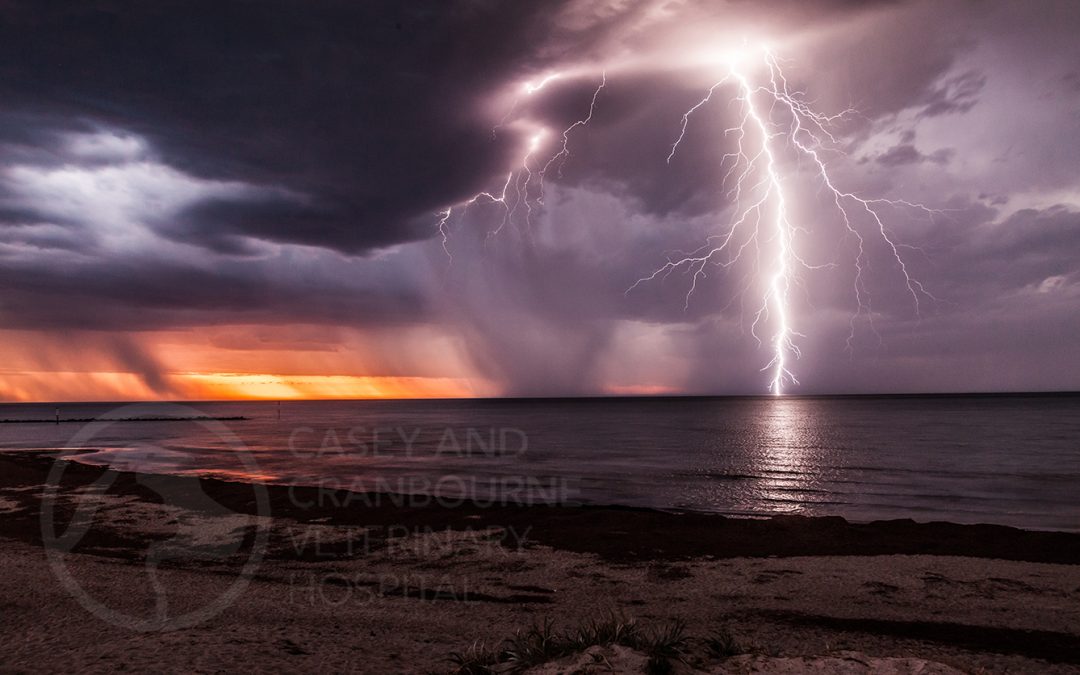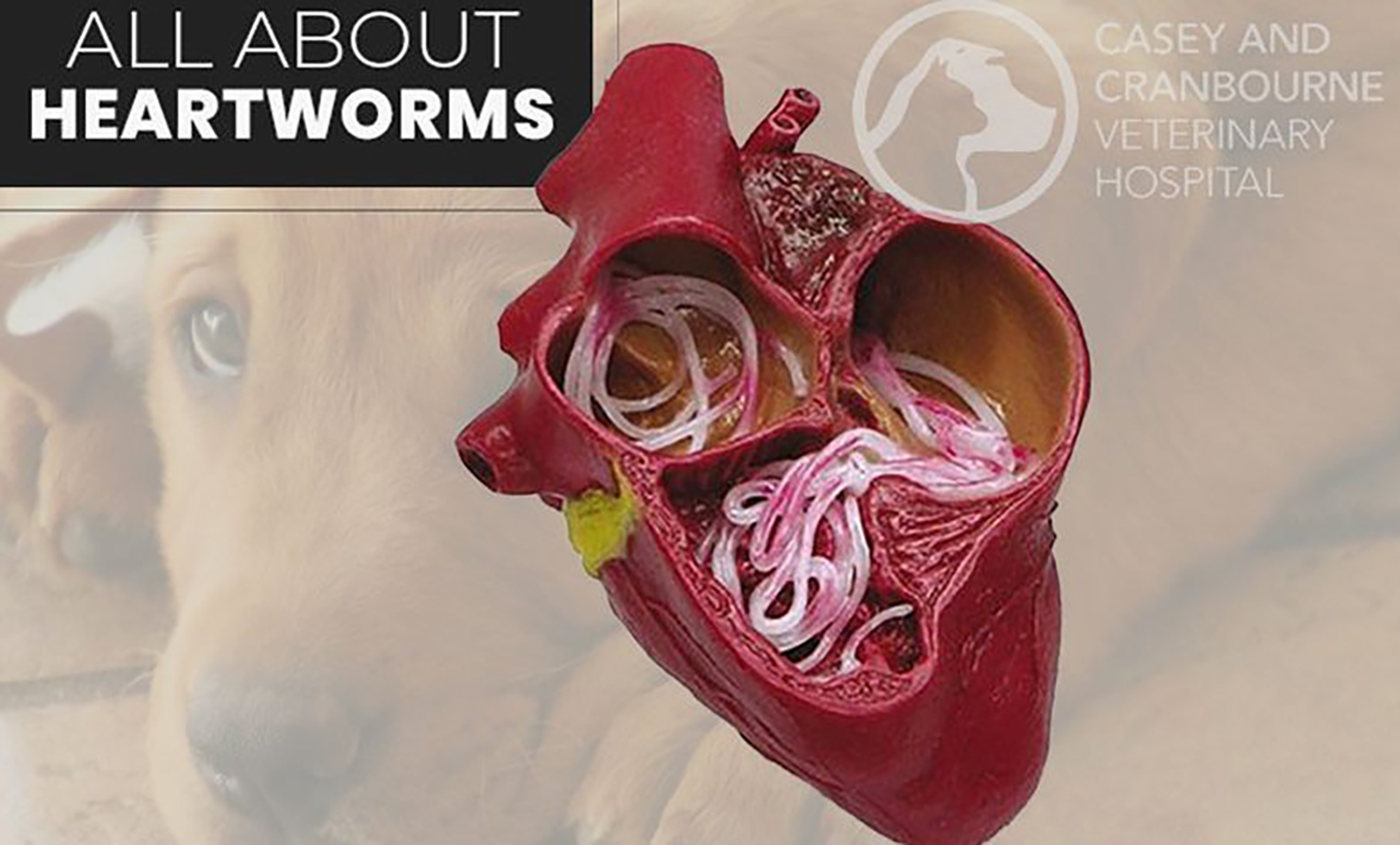As we head into summer, it’s the time when we see a lot of dogs suffering from noise phobias, be they thunderstorms or fireworks.
This article looks at the reasons behind thunderstorm phobia and ways to help your dog deal with this fear.
Thunderstorm phobia, also called fear of thunderstorms or storm phobia, is a common issue in dogs. The body’s response to fearful stimuli, such as loud thunder, is a normal way of protecting itself. However, the unnecessary stress on your pet for such common and natural occurrences can lead to a lot of problems. Common signs of thunderstorm phobia include hiding, shaking, crying or whining, excessive licking, urinating or defecating in the house, pacing, panting, drooling, restlessness, trying to escape into or out of the house/pen, or looking to an owner for comfort by pawing the owner, nuzzling, or whimpering.
Why are Some Dogs Afraid of Storms?
Thunderstorm fear and anxiety can occur for many reasons and at any age. We may never fully understand why it happens. Some dogs are just more prone to thunderstorm phobia or react more strongly to storms than others. Genetics, traumatic experiences, and/or poor socialisation or acclimation to storms and loud noises as a puppy could be contributing factors. For example, herding breeds tend to experience storm phobia more often than certain other breeds. Some researchers have found that female dogs are more likely to have it than males. Dogs who are partially deaf or only deaf in one ear cannot tell where the storm sounds are coming from and may react in a more extreme manner than dogs who can hear. Dogs with separation anxiety are much more likely to develop storm phobia. Genetically, certain hunting dogs may respond more intensely to thunder because it may be difficult for them to differentiate storm sounds from gunshot sounds.
Dogs can display fear before thunder, indicating the thunder is not the only fearful part of the storm. Darkening clouds, humidity alterations, changes in barometric pressure, wind, rain, and lightning can all lead to fear responses in a dog. It’s important to understand this because trying to minimise all of these stimuli during a storm, and not just thunder sounds, can help keep your pet relaxed.
Managing Thunderstorm Phobia
Helping your dog deal with storm phobia effectively often requires multiple methods of treatment. Always discuss your concerns with one of our vets first so that we can help you create a plan specific to your pet. Some common ways to treat or reduce storm phobia include:
- Being aware of high-risk days for storms by checking weather reports. Also, for events such as New Year’s Eve, consider staying home with your dog or having someone at home so your dog can be inside and not risk trying to escape the backyard. Fireworks definitely increase the sensitivity of dogs with noise phobia and may worsen their reaction to thunderstorms and other loud noises. Sometimes it is possible to organize for the animal to be transported to a quiet area, for example, an area of the house that has been soundproofed. Background “white noise”, ear covers and sound muting cage covers might also assist in reducing the intensity of the storm while room darkening shades may reduce the visual effects. Creating a ‘safe haven’ for the dog in an appropriate area of the house is recommended, ideally, it is best for your dog to choose to the place. Many dogs will have an area that they prefer to place themselves. Provided it is safe, this is the best place for the dog to be.
- Minimise the stimuli from a storm by limiting your dog’s exposure to it. This includes closing the blinds so your pet cannot see lightning; keeping your pet in an interior room, perhaps even one that has been sound-proofed so thunder and rain are muffled; and playing background white noise, such as boxed fan, or soothing music (e.g. classical music) during a storm. A crate covered with a blanket may help. It is important to monitor your pet if a crate is used to ensure he does not become more anxious while in the crate. Some dogs may feel trapped in such an environment. Creation of a safe haven for your dog in an appropriate area of the house is recommended, ideally, it is best for your dog to choose the location. provided it is safe, this is the best place for your dog to be. It is ok to offer comfort to your pet when they are anxious, remember to remain calm during your interactions. If you seem anxious, even if it is because you are worried about how your pet will react to the storm, your pet may pick up on your anxiety and become even more anxious and fearful.
- Playing with your pet as a distraction can be helpful. This can give your pet an outlet for some of that nervous energy they have built up, and a way to use it productively as opposed to destructively.
- Give your pet a chew toy or a treat-dispensing toy with food inside, such as peanut butter, or a food puzzle toy to distract them during the storm. Chewing is a proven stress reliever in dogs.
- Body wraps such as a Thundershirt may help keep your pet relaxed. This is a snug fitting pressure garment that is meant to have the similar calming effect as swaddling a baby. During summer, these can be wet down and applied cool to your dog as otherwise they may cause overheating. Headphones or ear muffs for dogs can decrease storm noises.
- Aromatherapy, including lavender and/or chamomile, or Adaptil pheromone therapy can help lessen your pet’s anxiety during storms.
- Never punish or yell at your pet for being afraid. If your pet is destructive or eliminates inappropriately during a storm, remember that it’s because they are afraid. Punishing them may worsen the storm phobia.
- Consider desensitisation CDs which means exposing your dog to the scary stimulus at a very low level so they are not scared then gradually increasing the volume of the noise as the dog exhibits an ability to cope. However, desensitisation alone is often not 100% successful. When it comes to storms, some dogs are scared of the sound of thunder. In these cases, a CD recording of thunder noises played initially at a low level and gradually increased over time, may help. However, other dogs have different triggers, such as wind, barometric pressure changes, lightning and rain. In these cases, desensitising is not possible.
- You can also look at counter conditioning which means trying to get the dog to have a response that is incompatible with the phobia. For example, playing with or feeding the dog treats while there is a noise CD on at a low level. This creates a connection between the sound of thunder and treats. The sound can gradually be increased. Your dog should never be punished for fearful behaviour as it will only make them more scared. The increasing intensity of the sound should be managed so that it is very gradual and never makes your dog fearful.
- Relaxation training is another option to try but this takes time, effort and repetition. Training your dog to settle and relax on their bed should be achieved before any scary sounds are added. This can be done by encouraging calm responses to cues (eg. ‘lie down’ or ‘settle’) and following it with a tasty treat. You should also be on the lookout for calm behaviour around the house, and reward that with a treat.
- Anti-anxiety medications are often needed to help reduce the anxiety associated with your pet’s storm phobia. These should be given an hour or more before the storm develops to have a chance to work. This makes it difficult as often dogs sense a storm is coming well before it is visible or audible to humans. Medication is usually used in combination with other storm phobia treatment methods as it reduces the level of fear and anxiety your pet has in order to allow other storm phobia treatment methods to work. If your dog has other behavioural problems, we may prescribe daily anti-anxiety medication, with an additional therapeutic agent given for use for noise phobias-storms, fireworks etc.
Noise phobias can be difficult to deal with and can be quite stressful for you and your dog. If you suspect or know that your dog suffers from thunderstorm or noise phobia or any other anxiety disorders, please book an appointment with one of our vets to discuss what treatment plan is best for your dog.



